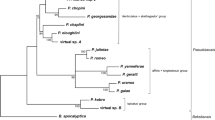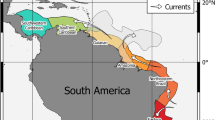Abstract
THERE is no fossil record of the freshwater Tricladida but they are particularly suitable organisms for zoogeographical studies because of their low vagility. Their dispersal powers have been reviewed by several workers1–3 and the general absence of resistant eggs or stages, and the fragility of adults have led to the conclusion that the usual agencies of intercontinental dispersal, such as wind, driftwood and birds' feet, have played little or no part in the dispersal of these organisms. Further, the differences in the triclad faunas of the freshwaters on either side of the English Channel, the Menai Straits (North Wales), Skagerrak and Kattegat3, and the Gulf of St Lawrence (unpublished data) may be taken as evidence of the efficacy of even narrow sea passages as barriers to the dispersal of members of the group. In fact, there are only two authenticated cases of passive dispersal in freshwater triclads. These are the introduction of Dugesia tigrina into Europe from North America4, and the recent introduction of D. lugubris into North America from Europe5. Both can unequivocally be attributed to the activities of modern man. It is also noteworthy that the three temporary water forms which come closest to possessing resistant stages, Fonticola velata, F. vernalis and Hymanella retenuova, all have a fairly restricted distribution in the north-eastern United States6. It may therefore be concluded that freshwater triclads are certainly of low vagility and that present day taxonomic and distributional data may be a good guide to their past history.
This is a preview of subscription content, access via your institution
Access options
Subscribe to this journal
Receive 51 print issues and online access
$199.00 per year
only $3.90 per issue
Buy this article
- Purchase on Springer Link
- Instant access to full article PDF
Prices may be subject to local taxes which are calculated during checkout
Similar content being viewed by others
References
Beauchamp, P. de., CR Soc. Biogéog., 17, 7 (1940).
Beauchamp, P. de., in Traité de Zoologie (edit. by Grassé, P.), 4 (Masson et Cie, Paris, 1965).
Reynoldson, T. B., Adv. Ecol. Res., 3, 1 (1966).
Dahm, A. G., Taxonomy and Ecology of Five Species Groups in the Family Planariidae (Diss., Univ. Lund).
Ball, I. R., J. Fish. Res. Bd. Canada, 26 (in the press).
Ball, I. R., Canad. J. Zool, 47, 59 (1969).
Marcus, E., Bol. Fac. Fil. Ci. Letr. Zoologia, 11, 5 (1946).
Marcus, E., in South African Animal Life (edit. by Hanström, Brinck and Rudebeck), 101 (Stockholm, 1955).
Brinck, P., Proc. Roy. Soc., B, 152, 568 (1960).
Beauchamp, P. de, Trans. Linn. Soc. Lond., 1, 51 (1939).
Marcus, E., Exploration du Parc National de l'Upemba, 21, 1 (Institut des Parcs Nationaux du Congo Belge, Brussels, 1953).
Meixner, J., Z. Morph. Ökol. Tiere, 2, 570 (1928).
Beauchamp, P. de., Mém. Mus. Nat. d'Hist. Nat. Paris, 14, 313 (1940).
McKenzie, K. G., and Hussain, S. U., Nature, 220, 806 (1968).
Illies, J., Ann. Rev. Entomol., 10, 117 (1965).
Brundin, L., Kungl. Svenska Vetensk. Handl., 11, No. 1 (1966).
Author information
Authors and Affiliations
Rights and permissions
About this article
Cite this article
BALL, I., FERNANDO, C. Freshwater Triclads (Platyhelminthes, Turbellaria) and Continental Drift. Nature 221, 1143–1144 (1969). https://doi.org/10.1038/2211143a0
Received:
Issue Date:
DOI: https://doi.org/10.1038/2211143a0
This article is cited by
-
Platyhelminths as paleogeographical indicators
Hydrobiologia (1995)
Comments
By submitting a comment you agree to abide by our Terms and Community Guidelines. If you find something abusive or that does not comply with our terms or guidelines please flag it as inappropriate.



